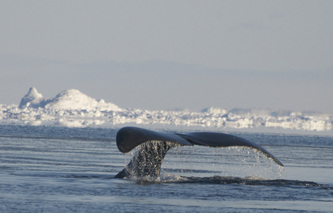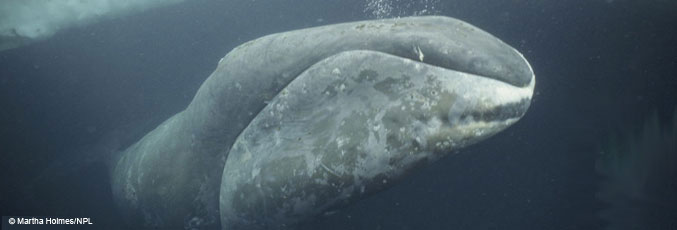
Have I mentioned how lucky I am to have been given the chance to study such a fascinating creature for my PhD? Well if not here are a few tidbits why. The bowhead whale, weighing in at around 120,000 lbs and growing to as much as 60 ft is the only mysticete whale to have evolved to live year round in the icy Arctic. And while this animals' impressive life span - estimated to be up to (and perhaps beyond) 200 years consistently cause jaws to drop a lesser known, and I think perhaps, an equally impressive characteristic of this whale surround it's acoustic abilities.
Yes whales produce sound; it is how they communicate. Large mysticetes tend to make rather odd moaning sounds of very low frequency and it is generally well known that male humpback whales sing intricate songs during the winter breeding seasons in a bid to attract females. If you ever find yourself in Hawaii' during the months of January and February try sticking your head under the sea - you will hear the chorus from male humpbacks. Research has confirmed that it is only the males that sing and for those that are aware that whales singing most only know about singing from humpbacks. But here they are wrong, oh so wrong. The bowhead whale is a singer too, in fact at times this rotund cold water creature could arguably rival the humpbacks singing ability.... or at least that is what I like to think.
Yet we know so little about the song of the bowhead whale, who is the singer? Is it just males that sing, as is the case with humpback whales or do females sing too? Why do these whales sing? are they singing for a mate? Bowheads in the Western Arctic have been recorded singing during the eastward spring migration and it is thought that these songs are the leftovers of much more active singing over the winter months. It is also suggested that singing is a method of maintaining connections between migrating groups. Bowheads in Disko Bay (off Western Greenland) have also been recorded to sing and songs are much more complex in the winter than than during the spring. But over the winter of 2008/2009 the crème de la crème of bowhead song was recorded and more exciting the 60 plus complex songs were recorded in the Fram Strait (to the east of Greeenland). The whales in this area are part of what is known as the Spitsbergen Stock. This stock of whales, once the largest of the bowhead stocks was the first to be targeted by commercial whalers as early as 1600 and were reduced to near extinction by early 1800.
The University of Washington researchers did not expect to get much from their 2 recording devices. But boy were they wrong. Between November 2008 and April 2009 the device located in the Western Fram Strait recorded whale songs nearly every hour and over 60 unique song patterns were detected. The authors of the this study (published in Endangered Species Research this year ) commented on the remarkable nature of such a diverse repertoire that approaches song birds rather than whales. The study also found that singing peeked with the lowest water temperatures, when ice conditions were most dense and while is was almost completely dark. The extent of the singing has suggested this population may be larger than previously thought and if bowheads do only sing during the breeding season then these recordings have provided some evidence of an active breeding part of this critically endangered population, which is always good news!
Research Article, freely available:
Stafford, K.M., S.E.Moore, C.L. Berchok, Ø. Wiig, C. Lydersen, E. Hansen, D. Kalmback and K.M. Korvacs. 2012.
Spitsbergen's endangered bowhead whales sing through the Polar night. Endangered Species Research. 18(95-103)
(These examples are available on the University of Washington Office of News and Information website)
Song 1
Song 2
These links take you to some of the press coverage, I have been a bit late in posting about this story but it is still so exciting that I think it continues to be worth sharing. Plus it is another reason for me to share with you why these whales are so fascinating.
Critically endangered whales sing like birds; new recordings hint at rebound (University of Washington)
Study: Chatty Arctic Bowhead whales sing like the birds (Alaska Dispatch)
Critically Endangered Whales Sing Like Birds; New Recordings Hint at Rebound (Science Daily)
Western Greenland Bowhead Acoustic Research:
http://diskobayarcticstation.wordpress.com/bowhead-whales/bowhead-whale-biology/
The North Slope Borough, Alaska: Bowhead studies and other bowhead sources
http://www.north-slope.org/departments/wildlife/Bowhead%20Whales.php



 RSS Feed
RSS Feed